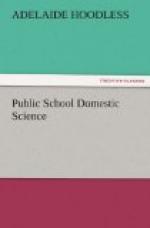The following outline is offered as a tentative plan of work, for an average class of girls, in the highest grades of the Public school. The exact order of lessons depends in a measure on the skill and interest of the pupils, and the special dishes selected to illustrate a principle, upon the circumstances of the pupils, and upon the season of the year.
It should be noted that beginning with the third lesson, there are four lessons on the cooking of carbohydrates; then four on the cooking of nitrogenous foods; next the batters, combining the two, and introducing the use of fat, and so on. It is the purpose of this arrangement to enforce the effects produced by heat on the food principles, singly and in combination; to alternate the groups, so that there is a constant review of principles already established; and to give practical work of increasing difficulty.
The course in cooking should be preceded by a few lessons in house-work; and at least one on the care of the kitchen. It is taken for granted that the lessons are accompanied by a study of food values, the cost of food, marketing, etc.
1. Simple experiments in combustion—to illustrate the structure of stoves and the care of such stoves. Study of the fuel and apparatus to be used in the school kitchen; practice in using the apparatus; comparison with other apparatus.
2. Utensils—what they are, of what materials, and why. It is well to have pupils make a list in note-book of simple kitchen furnishing.
Experiments with the boiling of water, in Florence flask, in tea-kettle, and in covered saucepan, using thermometer. Use of double boiler. Compare with boiling water the temperature of fat hot enough for frying, and also that of the oven. To illustrate the two latter, croutons may be made.
3. Measuring—experiment with the cooking of starch in water; cornstarch pudding, or tapioca or sago jelly. Develop the idea of the effect of the boiling temperature on the starch grains, the bursting of the grains, and the change in flavor due to continued cooking.
4. A cereal and a fruit,—say, baked apples. In the cereal, in addition to the starch, is the cooking of the woody fibre. Note in both cereal and fruit the flavors developed by heat, the cooking being a continuation, as it were, of the ripening process.
5. A starchy and a green vegetable; as, for instance, potatoes and cabbage. Here, again, are the two principles, cookery of starch and vegetable fibre; again the development of flavor by heat. Cookery of peas and beans would better be deferred until the pupils are familiar with the effect of water on nitrogenous substances.
If time allows, a sauce may be made to serve with a vegetable, or this may be given in the next lesson.
6. Vegetable soups, without meat stock. This is in part a review lesson. Opportunity is offered here for the study of proportions, several ingredients being used, how much vegetable pulp or juice to how much liquid; how much thickening, and how much salt to a quart of soup.




